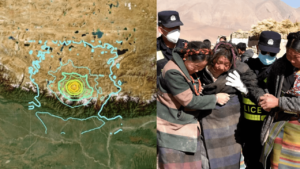Hurricane Debby is expected to impact Florida’s coast with heavy rainfall, storm surge, and gusty winds. The potential impacts of Tropical Storm Debby, including flooding rainfall, storm surge, gusty winds, and isolated tornadoes, underscore the importance of taking this storm seriously.

As the hurricane season unfolds, Florida finds itself in the crosshairs of a developing storm. Tropical Depression Four, currently situated near Cuba, is expected to intensify into Tropical Storm Debby. This potential tropical storm could reach hurricane strength before making landfall in Florida’s Big Bend region by Sunday night or early Monday. The National Hurricane Center (NHC) has issued a hurricane watch for parts of Florida’s coast, and the state is preparing for a range of severe weather impacts.
The Path and Intensity of Tropical Depression Four
Tropical Depression Four is currently tracking west-northwestward, with its rain bands already affecting southern Florida. The NHC forecasts that this system will become Tropical Storm Debby by Saturday night. As it moves towards Florida’s Big Bend region, it could strengthen into a strong tropical storm or possibly a Category 1 hurricane. It’s critical to realize that this system’s effects will extend far beyond its landfall point along the Florida Peninsula.
After landfall, the system is expected to track near the Southeast coast early next week, potentially intensifying again if it remains over water. There is an increasing likelihood that Tropical Storm Debby could slow down or even stall near the Southeast coast, prolonging its impacts, especially in terms of flooding rainfall.
Watches and Warnings in Effect
A hurricane watch is in effect for parts of Florida’s Big Bend, from Aucilla River to Yankeetown. Additionally, tropical storm warnings and watches cover much of western Florida, extending from the Keys to north of Tampa Bay and the easternmost Panhandle region. Additionally, a storm surge watch has been issued for the Florida peninsula’s west coast, which includes Tampa Bay and Charlotte Harbor and runs from Bonita Beach to the Aucilla River.
Breaking Down the Impacts
Flooding Rainfall
One of the most significant threats from Tropical Storm Debby is the potential for heavy rainfall and flooding. The system is likely to bring torrential rains to Florida this weekend, with the heaviest rain expected to linger into early next week. This heavy rainfall will also spread into eastern Georgia and the eastern Carolinas, posing a risk of flash flooding and isolated river flooding in these areas.
If Tropical Storm Debby slows down or stalls, it would exacerbate the flooding risk, as prolonged rainfall can lead to more severe flooding. The NHC has indicated that rainfall totals could reach 5 to 10 inches, with some areas potentially receiving up to 15 inches of rain. Given that rainfall flooding has been responsible for the most direct U.S. deaths from tropical storms and hurricanes since 2013, this aspect of the storm is particularly concerning.

Storm Surge
Coastal flooding from storm surge is another critical threat posed by Tropical Storm Debby. The NHC warns that the storm surge could reach 3 to 5 feet above normal tide levels if it coincides with high tide in Florida’s Big Bend region. Other areas, including Tampa Bay and Charlotte Harbor, could see a storm surge of 1 to 4 feet. Coastal flooding could also impact the Southeast coast early next week, although details are still emerging.
Wind and Tornado Threats
The Florida Peninsula will experience gusty winds throughout the weekend, particularly in the heavier bands of rain associated with the storm. Stronger wind gusts could lead to sporadic power outages and tree damage, especially near and inland from where the storm makes landfall. Additionally, there is a possibility of isolated tornadoes in Florida over the weekend.
Florida’s Preparedness Efforts
In response to the impending storm, Florida Governor Ron DeSantis has declared a state of emergency for 54 of the state’s 67 counties. This declaration aims to mobilize resources and ensure that the state is prepared for the potential impacts of Tropical Storm Debby.
The governor’s office has urged Floridians to monitor weather conditions closely, follow orders from local officials, and create disaster preparedness plans. Residents are encouraged to stock disaster supply kits with essential items such as food, water, prescription medicines, and other necessities. Additionally, sandbag distribution has begun in several communities in the Orlando and Tampa metropolitan areas, as well as in multiple counties in the state’s panhandle.
Hurricane Center Director Michael Brennan emphasized the importance of preparation, stating, “You still have some time to put your disaster supply kit together. Make sure you have multiple days of food, water, prescription medicines. Keep your gas tank full, cash on hand, and keep batteries. Make sure your phone’s charged and make sure you have a battery-powered radio.”
Potential Impacts on the Southeast Coast
After making landfall in Florida, Tropical Storm Debby is forecast to track to the northeast over portions of northern Florida and southern Georgia. However, there is a significant concern that the atmospheric components that help steer and push storms along could break down, causing the storm to slow significantly while over the Southeast early next week.
A slower-moving storm would dramatically increase the flood threat, as it would linger over the same areas and dump repeated bouts of heavy rain. The NHC predicts that 5 to 10 inches of rain, with potential for more, could fall over coastal portions of Georgia, South Carolina, and North Carolina. This prolonged rainfall could lead to significant flooding in these regions.
A Quick Review
As Tropical Depression Four intensifies and approaches Florida, it is crucial for residents to stay informed and prepared. The potential impacts of Tropical Storm Debby, including flooding rainfall, storm surge, gusty winds, and isolated tornadoes, underscore the importance of taking this storm seriously.
By staying updated on the latest forecasts and following the advice of local officials, Floridians can better protect themselves and their communities from the dangers posed by this developing storm.
Read Next:

The Psychology of Love: Why Valentines Day Matters More Epic Than You Think
Discover the psychology of love and why Valentines Day is more important than you think. Learn how love impacts the brain, strengthens relationships, and boosts

Premier League Highlights: Arsenal Humiliate Man City 5-1, Spurs and Palace Secure Crucial Wins
Arsenal demolished Manchester City 5-1 in a statement premier league highlights win, reigniting their title hopes. Meanwhile, Crystal Palace stunned Man United 2-0, and Tottenham

How Budget 2025 Impacts the Indian Middle-Class: Major Tax Benefits and Glaring Omissions
Budget 2025 offers major tax relief to the middle class, including zero tax on incomes up to ₹12 lakh. However, it misses out on incentives

Degrees vs Employability: Why “Highly Qualified Degree Holders” Struggle to Find Jobs While “Less Qualified Individuals” Get Hired Faster!
Many highly qualified individuals struggle to secure jobs, while less qualified candidates get hired quickly. This Degrees vs Employability paradox is caused by employer preferences,

The Power of Mindset: Why Looking Poor Doesn’t Make You Poor, but Thinking Poor Does!
Discover why looking poor doesn’t define your wealth but thinking poor does. Learn the power of mindset and how a growth-oriented mindset can lead to

Overthinking: How It’s Damaging Today’s Youth – Causes and Cure in 2025
Understanding how overthinking is silently damaging today’s youth, from its causes rooted in societal pressure and social media to its long-term effects on mental health.

Netaji Subhash Chandra Bose: An Epitome of Epic Leadership
Discovering the incredible life of Netaji Subhash Chandra Bose, a leader whose vision, courage, and determination redefined India’s freedom struggle. Explore his leadership qualities, ideology,

Global News Headlines Today: From Gaza Ceasefire to Blue Origin’s Massive 2025 Milestone
Explore today’s top global news headlines, from the Gaza ceasefire and Blue Origin’s historic spaceflight to Apple losing its top spot in China’s smartphone market.

The Hidden Danger of Social Media Nudity: A Threat to Today’s Youth in 2025
Understanding how social media nudity is impacting the youth and their future potential. Learn about the risks of unregulated content, cultural sensitivities, and solutions for

FA Cup 2024: Manchester United Survive Arsenal Test to Advance in FA Cup Fourth Round
Manchester United defeated Arsenal in a thrilling FA Cup third-round encounter, with Atlay Bayindir’s heroics sealing the win. Read about key moments, standout performances, and

Supercopa de España: Barcelona Dominate Real Madrid 5-2 to Claim Supercup
Barcelona delivered a stunning 5-2 victory over Real Madrid in the Supercopa de España final. Read about the key moments, star players, and the significance

Global News Highlights Today: India’s Metro Milestone, US Aid Shift, iOS Stunning Updates and More!
Explore today’s global news highlights, including the Tibet earthquake, political tensions in South Korea, LA wildfires, US aid shifts, and India’s metro milestone. Stay informed
